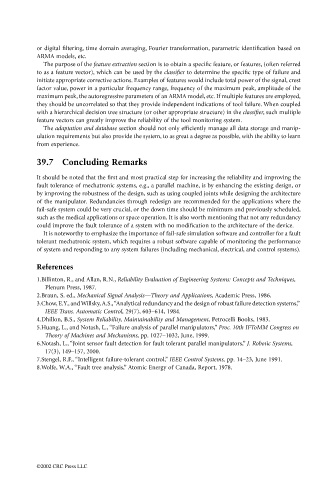Page 1090 - The Mechatronics Handbook
P. 1090
or digital filtering, time domain averaging, Fourier transformation, parametric identification based on
ARMA models, etc.
The purpose of the feature extraction section is to obtain a specific feature, or features, (often referred
to as a feature vector), which can be used by the classifier to determine the specific type of failure and
initiate appropriate corrective actions. Examples of features would include total power of the signal, crest
factor value, power in a particular frequency range, frequency of the maximum peak, amplitude of the
maximum peak, the autoregressive parameters of an ARMA model, etc. If multiple features are employed,
they should be uncorrelated so that they provide independent indications of tool failure. When coupled
with a hierarchical decision tree structure (or other appropriate structure) in the classifier, such multiple
feature vectors can greatly improve the reliability of the tool monitoring system.
The adaptation and database section should not only efficiently manage all data storage and manip-
ulation requirements but also provide the system, to as great a degree as possible, with the ability to learn
from experience.
39.7 Concluding Remarks
It should be noted that the first and most practical step for increasing the reliability and improving the
fault tolerance of mechatronic systems, e.g., a parallel machine, is by enhancing the existing design, or
by improving the robustness of the design, such as using coupled joints while designing the architecture
of the manipulator. Redundancies through redesign are recommended for the applications where the
fail-safe system could be very crucial, or the down time should be minimum and previously scheduled,
such as the medical applications or space operation. It is also worth mentioning that not any redundancy
could improve the fault tolerance of a system with no modification to the architecture of the device.
It is noteworthy to emphasize the importance of fail-safe simulation software and controller for a fault
tolerant mechatronic system, which requires a robust software capable of monitoring the performance
of system and responding to any system failures (including mechanical, electrical, and control systems).
References
1.Billinton, R., and Allan, R.N., Reliability Evaluation of Engineering Systems: Concepts and Techniques,
Plenum Press, 1987.
2.Braun, S. ed., Mechanical Signal Analysis—Theory and Applications, Academic Press, 1986.
3.Chow, E.Y., and Willsky, A.S., “Analytical redundancy and the design of robust failure detection systems,”
IEEE Trans. Automatic Control, 29(7), 603–614, 1984.
4.Dhillon, B.S., System Reliability, Maintainability and Management, Petrocelli Books, 1983.
5.Huang, L., and Notash, L., “Failure analysis of parallel manipulators,” Proc. 10th IFToMM Congress on
Theory of Machines and Mechanisms, pp. 1027–1032, June, 1999.
6.Notash, L., “Joint sensor fault detection for fault tolerant parallel manipulators,” J. Robotic Systems,
17(3), 149–157, 2000.
7.Stengel, R.F., “Intelligent failure-tolerant control,” IEEE Control Systems, pp. 14–23, June 1991.
8.Wolfe, W.A., “Fault tree analysis,” Atomic Energy of Canada, Report, 1978.
©2002 CRC Press LLC

